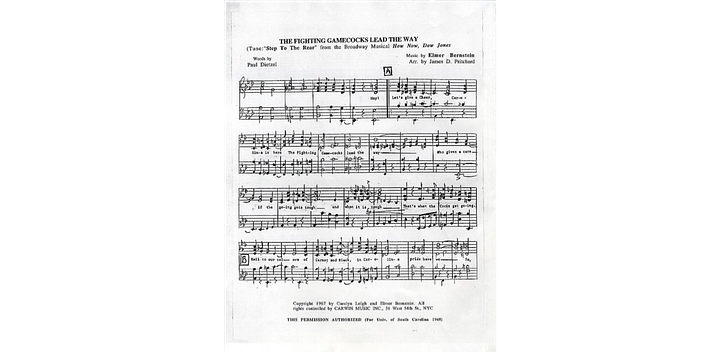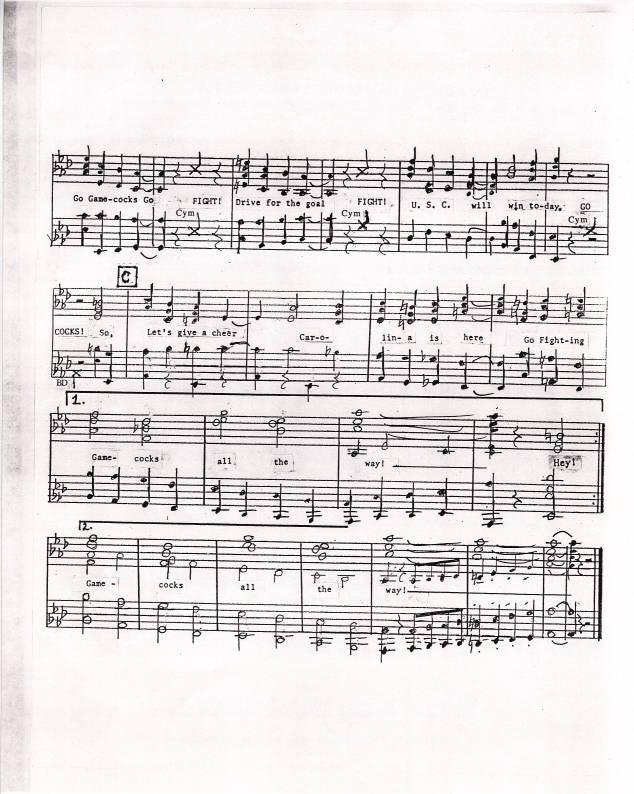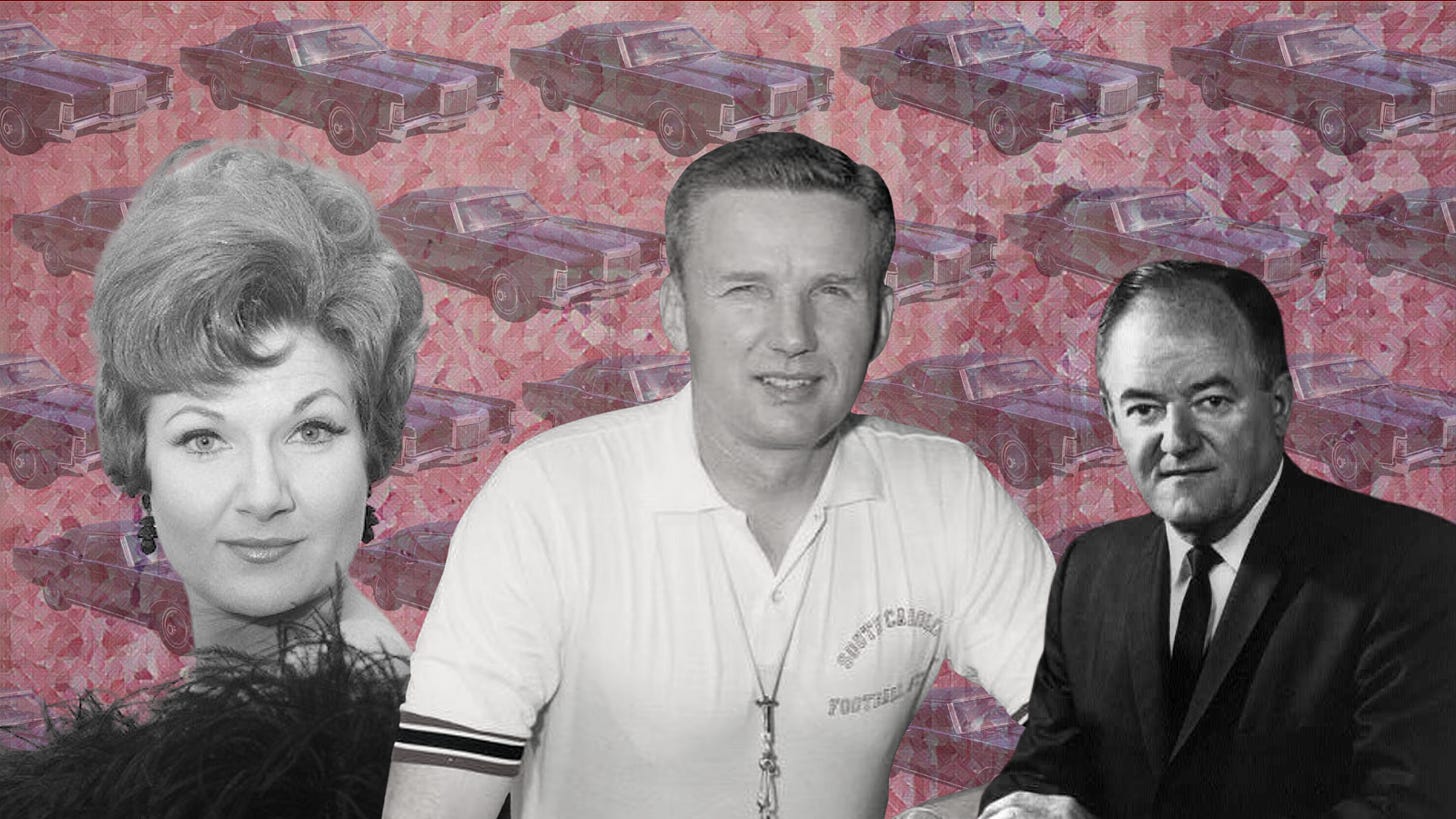The second life of 'Step to the Rear'
The year was 1968, and everyone -- football coaches, presidential candidates, easy listening artists, and car companies -- wanted a piece of 'Step to the Rear.'
A few months ago, I told you the bizarre story of How Now, Dow Jones, the Broadway flop that gave birth to the University of South Carolina’s fight song. Today, we pick the story back up where we left off:
And yet here we have a song — “Step to the Rear” — whose original context is that a bunch of old widows are trying to brighten the spirits of a young man who recently attempted suicide. It’s a song that comes in the middle of a poorly reviewed, scarcely seen play that only ran for seven months.
So how did it happen that a national-title winning football coach:
a) heard this song at all
b) heard this song and thought, “This would be a good fight song.”
c) heard this song and thought, “Not only would this be a good fight song, but it’s so good that we should use it to replace our existing fight song, which people seem to like just fine.”
d) was so adamant that this be the fight song that he concealed his involvement in writing the song from other head coaches at USC so that they wouldn’t get mad at him
Step To The Rear breaks from the pack
Here’s a thing that doesn’t even rank in the top 10 of the weirdest things about How Now, Dow Jones but is weird nevertheless and, importantly for our purposes, key to explaining how one of its songs ends up as the battle cry for South Carolina athletics: weeks before How Now opened on Broadway, “Step to the Rear” was recorded and released by the singer Marilyn Maye, entirely separately of the theatrical show. Maye’s recording became a minor hit on the Billboard Easy Listening charts, where it stayed until Feb. 1968.
Maye’s recording apparently made an impression on Vice President Hubert Humphrey, who began referencing it in speeches as early as May of ‘68. At a United Auto Workers convention in Atlantic City, Humphrey said, “So, will everyone here kindly step to the rear, as that song said a while ago, and let a winner lead the way — and I mean you. You have been leading the way and I don’t mind tagging along, if it is all right with you.”
At some point between that moment and the 1968 Democratic National Convention, Humphrey elevated “Step to the Rear” from ham-fisted pop culture reference to official campaign theme song. If you click here, you can watch a video of some incredibly earnest Humphrey supporters singing from song sheets at a rally in Chicago the night before the convention. (It may surprise you, as it did me, to learn that the height of cringe had already been achieved 50 years before the Mayor Pete dance was a twinkle in an Iowa staffer’s eye.)
Step also caught the ear of the Lincoln car company, which rewrote the words to promote its 1969 Marquis. I don’t have an exact date that this commercial first aired, but I have been able to ascertain that this line of cars was available for purchase starting in September 1968 — so very likely some time right around then.
Between Maye’s recording, Humphrey’s campaign song, and the Lincoln ad, Step to the Rear was — by the fall of 1968 — reaching a much broader audience than the short-lived musical for which it was written. This goes some distance toward explaining how the tune traveled from a musical hardly anyone saw to the ear of James Pritchard, the long-serving director of USC bands.
It’s Pritchard’s role in the story that often gets erased, probably because the idea of Dietzel as a songwriting football coach is way more captivating. But it was through Pritchard having his band play Step at USC football games in 1968 that Dietzel first heard the song. Dietzel was so taken with how it sounded that the football coach invited Pritchard to lunch and presented him with alternate lyrics. Pritchard wrote a new arrangement, and Dietzel — who was also the athletic director — made the unilateral decision that this would be the new fight song.


If you’re thinking that it sounds like a bad idea to have your football coach also be the athletics director, you’re absolutely right! This practice produced no shortage of infighting among South Carolina coaches and the university administration. More on that in a future post, very likely. I won’t say anything more about the topic now, except this: tensions were high enough that Dietzel felt he had to conceal his involvement in writing the fight song so that Frank McGuire wouldn’t get mad about it.
“Paul was afraid that if Frank McGuire knew he had something to do with the song,” Pritchard told The State in 2000, “then McGuire wouldn’t like it.”
But McGuire wasn’t the only one kept in the dark. The only way a USC fan of 1968 would have known about the change was if they’d attended the Nov. 16 game against Virginia Tech or heard Dietzel mention it during the Nov. 10 taping of his weekly TV show. One fan was so confused that they called in to the Columbia Record to ask why the band had stopped playing the fight song at basketball games. The answer, printed by the Record in March 1969, was doubtless the first time most fans were made aware there had been a change in fight songs.
Despite the muted and conspiratorial rollout, “The Fighting Gamecocks Lead the Way” became a staple at USC sporting events and, with the passage of decades, a firmly entrenched tradition. An entire generation of Gamecock fans were born and grew into adulthood, never knowing that the fight song had ever been anything else.
Not until the new millennium did anyone a) wish to challenge and b) have the clout to challenge the song’s position in USC culture. More on that in a future newsletter.





Great find! I knew some of this, mostly from the University side of things, but did not know just how popular the song was in '68. The Lincoln ad was great!